 |
Fort Ogé
Cayes-Jacmel, Haiti
|
|
 |
Constructed: 1804
Used by: Haiti
Conflicts in which it participated:
None
Also known as: Fort Cap-Rouge
|
Hispaniola* was a Spanish colony, established at the end of the 15th century. Spain did what it could to wring everything valuable from its new colony while simultaneously whittling down the native population for a few decades, but interest waned when cooler colonies were conquisted on the mainland of the Americas. Spanish power became concentrated in Santo Domingo on the eastern part of Hispaniola, leaving the western region free to host bases for Dutch, English and French pirates...because no matter how salty a pirate may be, he needs a place to store his booty. |
 |
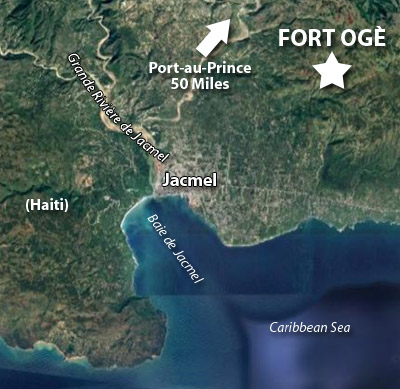 |
|
French colonization began in the 1620's, but it wasn't until 1665 that Sun King Louis XIV (1638-1715) made French ownership of the western third of Hispaniola semi-official, as the Spanish clearly weren't using it for anything constructive, and the resident pirates were forced to stow their booty elsewhere.
This new French colony was named Saint-Domingue, to cartographally differentiate it from Santo Domingo as clearly as possible. All of Hispaniola technically remained Spanish in ownership until 1697, when Spain ceded the western third of the island to France as part of the Treaty of Ryswick. This treaty concluded the Nine Years' War (1688-1697), one of Europe's interminable conflicts of this period, which were bad for Europeans but very good for starforts.
|
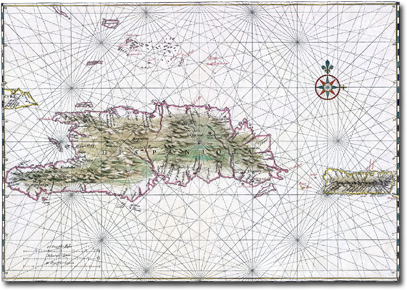 One of the first maps of Hispaniola and its neighbor Puerto Rico, from 1639 or thereabouts, cartographized by Dutchman Johannes Vingboons (1617-1670). |
 |
Saint-Dominigue became France's most prosperous colony, churning out sugar in great, profitable mounds, thanks to the tireless, selfless efforts of African slaves. Despite being completely satisfied with their situation, many of these slaves, seeing an opportunity in the upheaval caused by the French Revolution (1789-1799ish), revolted in 1791.
The previous year, one Vincent Ogé (1755-1791), a wealthy and educated "free man of colour" who had been born on Saint-Dominigue, returned to his homeland from Paris. Inspired by the lofty ideals spread by the French Revolution (behead everybody!), Ogé was determined to secure voting rights for free men of colour on Saint-Dominigue.
|
|
|
The colonial French authorities were loathe to grant such freedoms, and Ogé led a force of around 300 free men of colour to several victories against colonial militia. When a larger force of professional soldiers were sent against Ogé's merry band, however, the free army of colour was chased into Spanish Santo Domingo.
|
Ogé and 23 of his free associates of colour surrendered to Spanish authorities, upon guarantees of their safety. The Spaniards, however, immediately turned Ogé and his men over to the French colonial government, citing God's law that guarantees made to non-white persons are null and void (Ogé was a quadroon, considered "one-quarter coloured").
Vincent Ogé was broken on the wheel in a public square in La Cap, Saint-Dominigue on February 6, 1791. This was a punishment that varied in the particulars over different cultures, but which generally involved being tied down and having one's body parts bashed repeatedly with heavy things, providing a slow and unpleasant death for the recipient.
Remember the Ogé! did not become the rallying cry of those on Saint-Dominigue who sought independence from France, but it should have. In case you haven't made the connection yet, Fort Ogé was named for Vincent Ogé.
|
 |
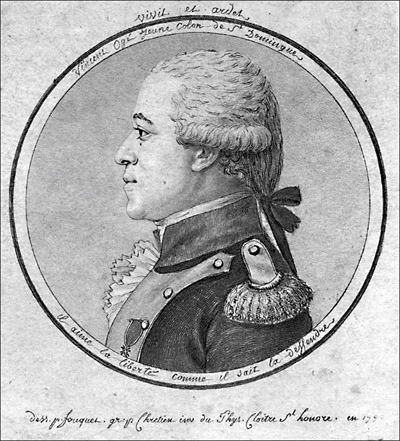 Vincent Ogé in 1790, by Fouquet. Vincent Ogé in 1790, by Fouquet. |
|
Inspired by the doings of Ogé, free men of colour and slaves alike continued the struggle. In 1792 France took the unprecedented step of banishing slavery from first the colony of Saint-Dominigue and then, six months later, in all French colonies, in hopes that this might cool the jets of those seeking independence. Which goal it achieved, sort of, for a little while, but by 1804 white persons had been almost completely ejected from, and/or killed upon, Hispaniola.
|
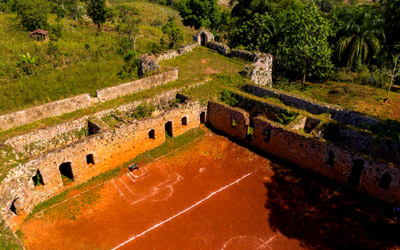 One of many fantastic pictures of Fort Ogé by Anton Lau. One of many fantastic pictures of Fort Ogé by Anton Lau. |
 |
The loss of the colony of Saint-Dominigue, costly in both francs and human life, was the straw that broke Napoleon (1769-1821)'s back, at least as far as his ambitions in the western hemisphere went. This was the reason that the Tiny Tyrant was willing, even eager, to sell the Louisiana Territory to the young United States in 1803.
Yes sir, France had had enough of the colonies-in-the-west thing, but those in the newly-independent Caribbean nation that had renamed itself Ayiti weren't so sure that France was done with them yet. |
|
|
A leader in the Haitian Revolution, who would go on to serve as its first Emperor, was Jean-Jacques Dessalines (1758-1806). Emperor Jacques I commanded that a chain of forts be built in strategic locations around Haiti in order to assure that, should the French return in strength, they would be stopped by cleverly-constructed masonry redoubts...most of which took the form of starforts. In all, at least twenty individual fortifications were built around Haiti immediately following its independence: Another that is profiled at Starforts.com is Fort Jacques in Port-au-Prince. Who designed these forts, and who built them? Thus far I haven't been seeing the names of the Haitian engineers responsible for their design, but after having been part of the French Empire for nearly 200 years, it's easy to surmise that there were at least a few locals who had been shipped to Paris and educated in the ways of Vauban, France's mystical Father of the Starfort. As for who did the actual building? When you're an Emperor, you generally have no problem with assigning large groups of your subjects to perform important slash hazardous duties such as building starforts!
|
Whomsoever may have designed Fort Ogé, it was built under the direction of General Magloire Ambroise (1774-1807), atop a hill that overlooks the town, and port, of Jacmel. Ambroise had been the commander in charge of Jacmel during the recent conflict with France, allowing the town to be captured in 1802, then redeeming himself by besieging it and forcing out the French in 1803. Haitian politics were vicious in the early days of its existence, however, and Ambroise died in a Haitian prison in 1807.
As things turned out, France did not make any further attempts to reclaim Haiti...because of the twenty(ish) starforts studding its coastline? Mmmaybe.
|
 |
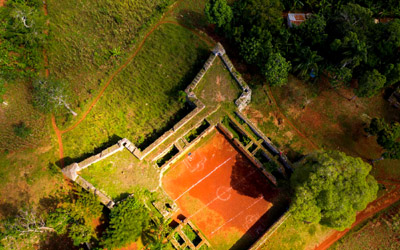 Another fantastic shot of Fort Ogé by Anton Lau. Do I wish this image included all of the fort? Yes, I do. Can I find Anton Lau's contact information to ask for the whole image? No, I cannot. Another fantastic shot of Fort Ogé by Anton Lau. Do I wish this image included all of the fort? Yes, I do. Can I find Anton Lau's contact information to ask for the whole image? No, I cannot. |
|
Despite being left alone by France and relieved of its Spanish domination in 1821, Hispaniola did not enjoy a peaceful 19th century. Squabbles both internal and external plagued Haiti, and by the turn of the 20th century it found itself in a situation it shared with several South American nations: Heavily in debt to European nations, and the United States breathing down its neck. Fearing foreign (German) intervention and/or the possible emergence of an anti-American government in Haiti, in 1915 US President Woodrow Wilson (1856-1924) sent in the Marines.
|
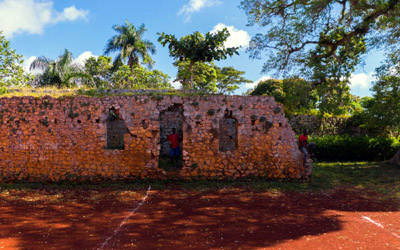
Yet another Anton Laupic, this one featuring some of the locals who keep Fort Ogé accessible to visitors. |
 |
US Marines remained in Haiti for nearly 30 years, adding significantly to the nation's infrastructure by building roads, hospitals, bridges and schools; by bringing safe drinking water to its cities; by enabling Port-au-Prince to be the first Caribbean city with an "automatic-dialing" phone system...but also killing anywhere from 3,250 to 15,000 Haitians who weren't going along with the program.
Did Fort Ogé play any role in the United States' occupation of Haiti? Probably not, but there reportedly is some Marine grafitti left behind on Fort Ogé's walls...because Kilroy was there. |
|
|
Today, Fort Ogé is maintained by the folks who live in its shadow, and is one of Haiti's lesser-visited tourist attractions. As we see from Anton Lau's images, the interior of the fort is entirely occupied by a soccer field, upon which the local youth regularly plays. One wonders if the interior walls of the fort serve the same function as bumpers in bowling, preventing the ball from ever going out of bounds?
*I really wish I could just refer to Hispaniola as Hispañola, as it was originally known to Spain as La Española, and I really really love the letter ñ, but apparently it's actually known as "Hispaniola" to the western world...because nobody knows how to cause an ñ to appear on either a monitor or a piece of paper.
|
|
|
|
|
|
 |




